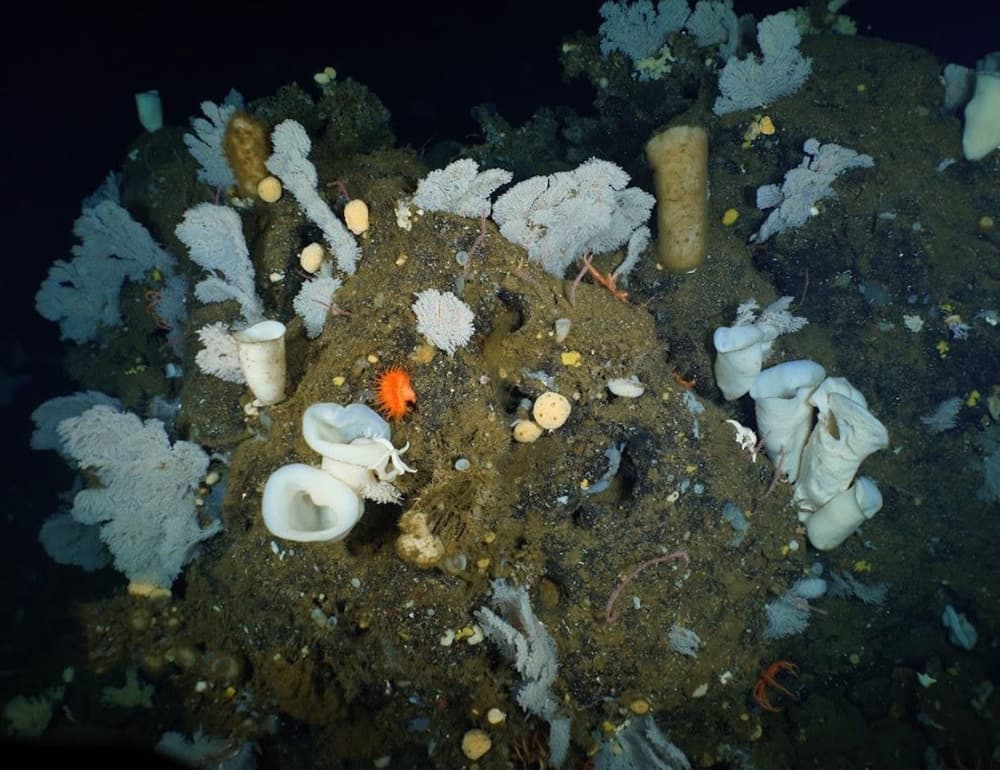Deep Sea Exploration, Characterization, and Monitoring
Conservation Issue

There is a lack of basic information about the seafloor within and surrounding Channel Islands National Marine Sanctuary (CINMS). Even less is known about the diversity and distribution of deep-sea benthic biogenic habitats (deeper than 30 meters), such as soft sediment communities and structure-forming deep-sea corals and sponges, as well as the communities that rely on them. Structure-forming invertebrates significantly increase seafloor diversity and provide essential habitat for commercially fished species and are unfortunately vulnerable to bottom contact fishing gear, marine debris, oil spills, increasing temperatures, and ocean acidification. Sanctuary managers cannot proactively protect sensitive marine resources that are at risk from human disturbances without fundamental knowledge of their abundance and distribution.
Description
Roughly 90% of the seafloor within CINMS extends beyond depths accessible by non-specialized scuba (100 feet). Due to operational costs of ship time and advanced submersible technologies, as well as the expanse of deep-water habitats in the sanctuary, only a very small fraction of the seafloor has been visually surveyed. However, from our limited observations, we know that CINMS is home to vibrant deep-sea coral, sponge, fish, and invertebrate communities. Deep-sea coral and sponge assemblages are particularly vulnerable to both physical disturbances and environmental change due to their late maturity, limited ability to adapt physiologically, and fragile structure. Even though these environments are deep, typically stable, and cooler than surface waters, changing ocean conditions may drastically alter deep sea conditions and therefore adversely affect species with low tolerances to changes in abiotic conditions. Mobile species, like fish and invertebrates, are also likely to respond to changing conditions and biogenic habitat, altering overall benthic biodiversity in the deep sea. Because there is little information available on the distribution, species composition, and condition of these habitats, the extent to which they overlap with potentially harmful human activities, and the rate at/magnitude to which deep-water environments are changing, sanctuary managers are unable to adequately track and conserve sensitive deep-sea habitats, such as deep-sea coral and sponge assemblages.
Data and Analysis Needs
- Distribution of benthic habitat types and validation of seafloor mapping data
- Identification of benthic communities that are biodiversity hotspots, as well as those most at risk from human-induced disturbances and changing ocean conditions
- Present day baselines of species densities, health, and community composition to allow for future reassessment
- Associations between fished species and coral and sponge assemblages
- Evidence of positive or negative human impacts, such as observations of marine debris
- Environmental conditions in deep water habitats, primarily rocky habitats that support corals and sponges
- Population connectivity within and among sanctuary habitats and the larger California Current ecosystem
- Patterns of human activity in the sanctuary and the extent of overlap between potentially harmful activities and known deep-sea coral and sponge distributions
- Information on the response, resilience, and recovery potential of vulnerable benthic habitats following injury due to human disturbance, changing ocean conditions, marine debris, and/or natural damage such as falling over in currents or predation (i.e., natural mortality, reproduction, and maturation rate information to determine recolonization times)
Potential Products
- Maps of physical and biological habitat types within CINMS, as well as distributions of relevant human activities
- Comprehensive inventory of field expeditions, data acquisitions, and data analyses
- Image library of representative habitats and human impacts to support education and outreach
Supplementary Information
Sanctuary Integrated Monitoring Network (SIMoN) Resources:
- Climate vulnerability assessment for deep-sea coral ecosystems in Channel Islands National Marine Sanctuary
- NOAA's deep-sea coral FY2010 assessment for the U.S. West Coast
- Return to the Northern Channel Islands to monitor change over time, inside and outside of marine protected areas
For more information about this assessment, contact research.CINMS@noaa.gov

